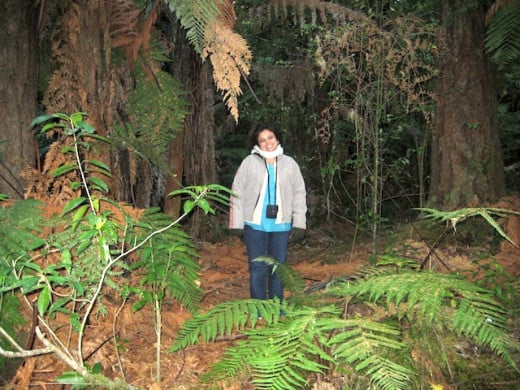Coast Redwoods – Tallest and Largest Trees in the World
Redwoods in Rotorua

The World's Largest Living Things
The world’s largest and tallest living things are the redwood trees in California, the tallest, Tall Tree, measuring 367.8 feet in height and 10 feet in diameter five feet above the ground. They can live for more than 2000 years.
The Tall Tree rises higher than a 35 storey building. It boasts engineering that no manmade structure could match, for it rests on a shallow bed of roots that go no deeper than 6 feet and no wider than 50 feet from its base. If the tree begins to lean or is damaged at one part of the base, it will grow a buttress to compensate for the added load on one side.
Redwoods in New Zealand
The Coast Redwoods have been cultivated in other areas of the world – including Britain, Europe, Asia, Australia and New Zealand but achieves its majestic heights and lush groupings only in the Pacific Coast.
The climate of New Zealand is more hospitable to both the North American sequoias, particularly in the North Island. A 15 acre grove of Coast Redwoods was planted near Rotorua in 1901; its trees were pruned to a height of 50 feet in 1939, and since then the tallest specimens have grown to heights of 170 to 185 feet. This redwood grove is part of the 18,000 acre Whakarewarewa National Forest, which is a primary research station for timber crop trees, as well as a popular recreational area in New Zealand.
This redwood grove is not intended for use as future lumber since it was dedicated in 1947 as a memorial to all members of the New Zealand Forest Service who died in the two world wars.
The Whakarewarewa Forest Park is one of the oldest exotic forests in New Zealand and is managed primarily for wood production. There are fine old stands of eucalyptus, sweet chestnut, larch, walnut and other introduced trees. Tall tree ferns and native shrubs provide an attractive under storey.




Types of Redwoods
Two distinct trees, coast redwood and the giant sequoia, are commonly known as redwoods and the tree most widely known as the redwood is the Coast Redwood (sequoia sempervirens). This species claims the tallest known standing tree, Tall Tree and was discovered in 1963 near the Pacific Coast in northern California, USA. Redwoods are conifers since they produce cones that carry their seeds.
The coast redwood and giant sequoia (sequoiadendron giganteum) are the descendants of the first conifers, which were born in the Triassic period of geologic time, more than 200 million years ago. Conifers were the first true trees and dominated the forests during the time of dinosaurs. Few living things have the geologic consistency and continuity that redwood trees demonstrate.
How do they grow?
These gigantic trees grow from tiny seeds measuring 123,000 to a pound, or more commonly from a sprout at the base of a tree. The coast redwood is the only conifer that can send vertical sprouts up from the lateral roots lying near the surface of the soil; often nearly a hundred young sprouts surround an established tree. It is this pattern of regeneration that results in the characteristic circular grove of this species. They require moisture in great measure.
The redwood trees have a close relationship to the largest of oceans, Pacific Ocean, prospering only where winter rains and summer fog maintain an even temperature and a minimum level of moisture. Hence they are limited to the Pacific coast beginning in the southwest corner of Oregon and ending in Santa Lucia Mountains south of Carmel, California.

Conclusion
These gigantic trees should be protected for future generations to admire and learn from. The Save the Redwoods League founded 90 years ago in the USA has been actively involved in their preservation. For more details on the redwoods log on to www.savetheredwoods.org
During the Christmas break we travelled from Auckland to Christchurch (Canterbury) by car and visited the Redwoods, Waitomo Caves, Lake Taupo among many other destinations. Having the right resources is very helpful in finding your way around. Lonely Planet books are very well researched. Another option is to visit the i-site in the places you visit. The staff there are very helpful.
Other Interesting Articles about New Zealand
- Waitomo Caves – Underground Limestone Formations a...
Explore the underground life of planet earth in these caves formed over millions of years. Waitomo Caves with its limestone formations and glowworms offer many adventure activities like abseiling, caving and black water rafting. - Canterbury New Zealand Tourism
The Canterbury region is situated in New Zealand's South Island. Christchurch City is the gateway to the Canterbury region, one of the most diverse corners of the world. Here you will find sparkling beaches, extinct volcanoes, hectares of farmland... - Mahatma Gandhi Statue in Wellington, New Zealand
The Mahatma Gandhi Statue in Wellington, New Zealand reminds us of a great man whose influence has spread far and wide. It was unveiled in 2007 on the International Day of Non-violence as declared by the United Nations.














